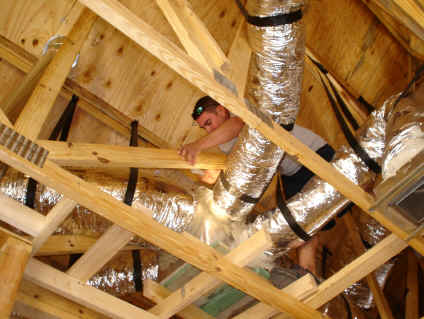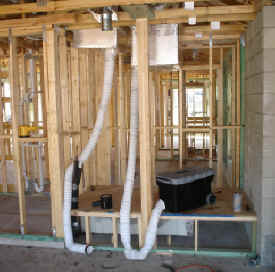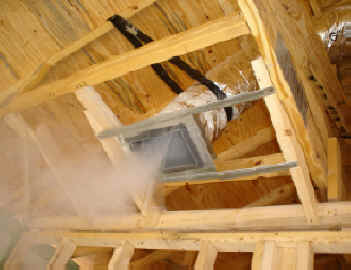Achieving Leak free Ducts for Energy Code Compliance: Smoke Test and Verify
By Jon Klongerbo
Calcs-Plus
Recent changes in the
Florida Energy Code may require builders to re-evaluate energy efficiency
measures included in their homes in order to pass code. One credit, the
leak-free duct credit, provides a 9% benefit for code compliance. For
comparative purposes, including this credit has about the same impact as raising
the air conditioning (AC) system SEER rating from 13 to 15. However,
verification is required by a state certified energy rater.
Leak-Free Duct Credit
Specifics
To receive the duct
system credit, leakage must be less than 3% Total Duct Leakage (3 cfm/100 square
feet). Or the leakage must be less than 9% Total Duct Leakage, and less than 3%
leakage to unconditioned spaces (Out Leakage). Since less than 3% Total Duct
Leakage is extremely difficult to achieve (air handlers alone leak 1-3%), only
the second option, 9% Total Duct Leakage with 3% Out Leakage, will be covered in
this article. Sampling is prohibited for receiving this energy code
credit.
A blower door must be
used in conjunction with a duct tester to measure Out Leakage. The duct tester
alone is used to measure Total Duct Leakage. The blower door-duct tester
combination is required to test for the practical and achievable option. No
substitutes for estimating duct leakage (such as pressure pan testing) are
allowed. When claiming the duct leakage credit, measurements entered into the
state’s duct compliance form and general energy code compliance form (Form
600A) must be submitted to the building department and signed by both the rater
of record and building official.
Effort to receive the
Leak-Free Duct Credit
Although the credit is
reasonable and achievable, it is by no means automatic. Conscientious efforts
must be taken to identify areas of leakage early-on, prior to final system
testing. Detecting and fixing problems at rough-in can be both a time and
cost-saver. Once the final
installation is complete, a leakage test is performed on the entire air
distribution system, including the air handler enclosure, to verify that the
system meets the duct leakage credit specifications.
Smoke testing the
ductwork at rough-in will identify leaks and allow duct installers to remediate
any failures early on. Smoke testing involves temporarily sealing the register
boxes and introducing theatrical fog into the duct system under slight pressure.
Previously invisible leaks can be identified easily and repaired with this qualitative
testing method. This step is imperative, since a failure at final
testing will be costly, difficult to remediate and delay the CO. Other
advantages of performing a smoke test at rough-in include:
·
Better home
comfort, lower operating costs and fewer client call-backs.
·
Reduced
installation costs by remediating problems at rough-in.
·
Improved
installation quality control, therefore creating an optimal performing duct
system.
·
Protection of
duct system from contamination because temporary seals remaining on registers
throughout construction.
·
Improved
indoor air quality and home durability and reduced health and safety problems
associated with duct leakage.
·
Better
subcontractor performance, since work is thoroughly inspected and failures
remediated.
·
Complementary
effort to demand side management and energy efficiency programs which
require specific duct leakage results for program participation.
|
Portable Smoking System Configuration when connected |
Most Remote register temporarily unsealed to allow fog to flow through entire Duct System |

Duct Technician attending to leakage identified by
smoke testing. Failures addressed now, will not be measured as leaks
later, when it is too late or too difficult to correct them.
Smoke Testing Field
Results
Recent smoke tests
conducted by the author gathered data on 82 homes.
All of the homes were constructed in the same subdivision, by the same
builder, using the same AC contractor. All homes were single story with
single system installations. A subjective grade was given to each duct system
based upon the severity of leakage observed before sealing. A
"tight" system indicated no observed failures. A
"leaky" system could be a severe failure, multiple failures or a
combination.
The AC contractor was
aware that all houses were to be smoke-tested and failures remediated.
Though some crews were able to install tight systems after a period of
adjustment, 23 homes (28%) still had Level 4 or 5 leakage at initial inspection.
Rotation of crews, new personnel, work load, and crew work interruptions during
installation most likely accounted for these high leakage results.
|
|
Comparative
Level of Leaks (scale from 1-5) |
|
|
||||
|
|
Tight |
|
|
|
Leaky |
|
Avg. |
|
Level |
1 |
2 |
3 |
4 |
5 |
|
2.68 |
|
Count |
22 |
15 |
22 |
13 |
10 |
|
Total |
|
|
|
|
|
|
|
|
82 |
Cost of Smoke and
Duct Testing for Energy Code Credit
On a single system house
you should expect a cost between $250 and $350 for final duct testing and
approximately the same cost for smoke testing. The cost of smoke testing
could easily be included as a quality control requirement in AC contractor’s
installation agreement. Additional variables, like travel distance and volume of
homes being tested, could alter these prices somewhat.
Conclusion
As a builder, a tight
duct system should be specified in the duct system installation contract.
Most other energy efficiency measures installed in your homes come with
advance specifications. But, since duct system leakage is a factor of
installation rather than a defined, absolute specification, it must be tested to
determine the quality. Verification
by an experienced third party will assure both you and your homeowners that
you are receiving what you have paid for. The leak-free duct credit is
confirmation of installation quality and it bestows upon the conscientious
builder a significant credit towards energy code compliance.
Jon Klongerbo is a state-certified residential energy rater
who has performed hundreds of duct tests in support of different Federal, State
and Utility programs and for diagnostic investigations. He is currently
involved with private development and introduction of innovative, practical and
understandable duct testing systems and protocols for common usage.

